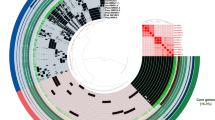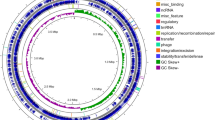Abstract
Limited microbial genera such as Streptomyces have served as sources of natural products (NPs), whereas most others have been less investigated. The vast accumulation of genomic data available in the NCBI database enables us to bioinformatically estimate the ability of other microbial groups to produce NPs. We analyzed 21,052 complete bacterial genome sequences using antiSMASH and compared the average numbers of biosynthetic gene clusters (BGCs) related to polyketides, non-ribosomal peptides, and/or terpenes biosynthesis at the genus level. Our bioinformatic analyses showed that Tumebacillus has 5–15 BGCs and is a promising NP producer. We searched for NPs from the culture broth of Tumebacillus permanentifrigoris JCM 14557T and found two novel compounds (tumebacin with anti-Bacillus activity and tumepyrazine) and identified two known compounds. Our results highlight the diversity of sources of NPs awaiting discovery.
This is a preview of subscription content, access via your institution
Access options
Subscribe to this journal
Receive 12 print issues and online access
$259.00 per year
only $21.58 per issue
Buy this article
- Purchase on Springer Link
- Instant access to full article PDF
Prices may be subject to local taxes which are calculated during checkout


Similar content being viewed by others
References
Newman DJ, Cragg GM. Natural products as sources of new drugs over the nearly four decades from 01/1981 to 09/2019. J Nat Prod. 2020;83:770–803.
Atanasov AG, Zotchev SB, Dirsch VM, Supuran CT. Natural products in drug discovery: advances and opportunities. Nat Rev Drug Discov. 2021;20:200–16.
Bérdy J. Thoughts and facts about antibiotics: where we are now and where we are heading. J Antibiot. 2012;65:385–95.
Pidot SJ, Coyne S, Kloss F, Hertweck C. Antibiotics from neglected bacterial sources. Int J Med Microbiol. 2014;304:14–22.
Müller R, Wink J. Future potential for anti-infectives from bacteria—how to exploit biodiversity and genomic potential. Int J Med Microbiol. 2014;304:3–13.
Hoffmann T, Krug D, Bozkurt N, Duddela S, Jansen R, Garcia R, et al. Correlating chemical diversity with taxonomic distance for discovery of natural products in myxobacteria. Nat Commun. 2018;9:803.
Medema MH, Kottmann R, Yilmaz P, Cummings M, Biggins JB, Blin K, et al. Minimum information about a biosynthetic gene cluster. Nat Chem Biol. 2015;11:625–31.
Ueoka R, Bhushan A, Probst SI, Bray WM, Lokey RS, Linington RG, et al. Genome-based identification of a plant-associated marine bacterium as a rich natural product source. Angew Chem Int Ed. 2018;57:14519–23.
Medema MH, Blin K, Cimermancic P, de Jager V, Zakrzewski P, Fischbach MA, et al. antiSMASH: rapid identification, annotation and analysis of secondary metabolite biosynthesis gene clusters in bacterial and fungal genome sequences. Nucleic Acids Res. 2011;39:W339–46.
Blin K, Shaw S, Steinke K, Villebro R, Ziemert N, Lee SY, et al. antiSMASH 5.0: updates to the secondary metabolite genome mining pipeline. Nucleic Acids Res. 2019;47:W81–7.
Steven B, Chen MQ, Greer CW, Whyte LG, Niederberger TD. Tumebacillus permanentifrigoris gen. nov., sp. nov., an aerobic, spore-forming bacterium isolated from Canadian high Arctic permafrost. Int J Syst Evol Microbiol. 2008;58:1497–501.
Baek SH, Cui Y, Kim SC, Cui CH, Yin C, Lee ST, et al. Tumebacillus ginsengisoli sp. nov., isolated from soil of a ginseng field. Int J Syst Evol Microbiol. 2011;61:1715–9.
Wang Q, Xie N, Qin Y, Shen N, Zhu J, Mi H, et al. Tumebacillus flagellatus sp. nov., an α-amylase/pullulanase-producing bacterium isolated from cassava wastewater. Int J Syst Evol Microbiol. 2013;63:3138–42.
Her J, Srinivasan S, Lee SS. Tumebacillus luteolus sp. nov., isolated from soil. Int J Syst Evol Microbiol. 2015;65:4107–12.
Prasad RV, Bhumika V, Anil Kumar P, Srinivas NRT. Tumebacillus lipolyticus sp. nov., isolated from river water. Int J Syst Evol Microbiol. 2015;65:4363–8.
Wu YF, Zhang B, Xing P, Wu QL, Liu SJ. Tumebacillus algifaecis sp. nov., isolated from decomposing algal scum. Int J Syst Evol Microbiol. 2015;65:2194–8.
Kim JH, Kim W. Tumebacillus soli sp. nov., isolated from non-rhizosphere soil. Int J Syst Evol Microbiol. 2016;66:2192–7.
Sung H, Kim HS, Lee JY, Kang W, Kim PS, Hyun DW, et al. Tumebacillus avium sp. nov., isolated from the gut of a cinereous vulture, Aegypius monachus. Int J Syst Evol Microbiol. 2018;68:1659–64.
Kang M, Chhetri G, Kim J, Kim I, So Y, Seo T. Tumebacillus amylolyticus sp. nov., isolated from garden soil in Korea. Int J Syst Evol Microbiol. 2022;72:005376.
Hanawa F, Tahara S, Towers GHN. Antifungal nitro compounds from Skunk Cabbage (Lysichitum americanum) leaves treated with cupric chloride. Phytochemistry. 2000;53:55–8.
Li S, Wu X, Zhang L, Shen Y, Du L. Activation of a cryptic gene cluster in Lysobacter enzymogenes reveals a module/domain portable mechanism of nonribosomal peptide synthetases in the biosynthesis of pyrrolopyrazines. Org Lett. 2017;19:5010–3.
Clark K, Karsch-Mizrachi I, Lipman DJ, Ostell J, Sayers EW. GenBank. Nucleic Acids Res. 2016;44:D67–72.
Eloff J. A sensitive and quick microplate method to determine the minimal inhibitory concentration of plant extracts for bacteria. Planta Med. 1998;64:711–3.
Weinstein MP, Lewis II JS, Bobenchik AM, Campeau S, Cullen SK, Galas MF, et al. Performance standards for antimicrobial susceptibility testing. M100 30th ed. Wayne: Clinical and Laboratory Standards Institute; 2020.
Dictionary of natural products on DVD. Boca Raton: CRC Press, LLC; 2016.
Ikeda H, Matsumori N, Ono M, Suzuki A, Isogai A, Nagasawa H, et al. Absolute configuration of aflastatin A, a specific inhibitor of aflatoxin production by Aspergillus parasiticus. J Org Chem. 2000;65:438–44.
Michael AP, Grace EJ, Kotiw M, Barrow RA. Ravenic acid, a new tetramic acid isolated from a cultured microfungus, Penicillium sp. J Nat Prod. 2002;65:1360–2.
Ratnayake AS, Davis RA, Harper MK, Veltri CA, Andjelic CD, Barrows LR, et al. Aurantosides G, H, and I: three new tetramic acid glycosides from a papua new guinea Theonella s winhoei. J Nat Prod. 2005;68:104–7.
Rutledge PJ, Challis GL. Discovery of microbial natural products by activation of silent biosynthetic gene clusters. Nat Rev Microbiol. 2015;13:509–23.
Baral B, Akhgari A, Metsä-Ketelä M. Activation of microbial secondary metabolic pathways: avenues and challenges. Synth Syst Biotechnol. 2018;3:163–78.
Acknowledgements
We are grateful to Distinguished Emeritus Professor Satoshi Ōmura (Kitasato University) for his helpful support and valuable guidance and suggestions. We are grateful to Dr. Kenichiro Nagai and Ms. Noriko Sato (School of Pharmacy, Kitasato University) for the mass and NMR spectral measurements. This study was partially supported by the Platform Project for Supporting Drug Discovery and Life Science Research (Basis for Supporting Innovative Drug Discovery and Life Science Research; BINDS) of the Japan Agency for Medical Research and Development (AMED) under Grant Numbers JP19am0101096 and JP22ama121035.
Author information
Authors and Affiliations
Corresponding author
Ethics declarations
Conflict of interest
The authors declare no competing interests.
Additional information
Publisher’s note Springer Nature remains neutral with regard to jurisdictional claims in published maps and institutional affiliations.
Supplementary information
Rights and permissions
Springer Nature or its licensor (e.g. a society or other partner) holds exclusive rights to this article under a publishing agreement with the author(s) or other rightsholder(s); author self-archiving of the accepted manuscript version of this article is solely governed by the terms of such publishing agreement and applicable law.
About this article
Cite this article
Kikuchi, Y., Kawashima, M., Iwatsuki, M. et al. Comprehensive analysis of biosynthetic gene clusters in bacteria and discovery of Tumebacillus as a potential producer of natural products. J Antibiot 76, 316–323 (2023). https://doi.org/10.1038/s41429-023-00609-y
Received:
Revised:
Accepted:
Published:
Issue Date:
DOI: https://doi.org/10.1038/s41429-023-00609-y
This article is cited by
-
Emblestatin: a new peptide antibiotic from Embleya scabrispora K20-0267
The Journal of Antibiotics (2023)



